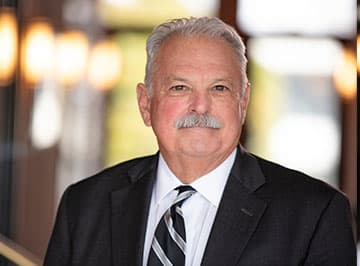How Old Do You Have to Be to Ride on the Back of a Motorcycle in Virginia
Can a Child Ride as a Passenger on a Motorcycle in Virginia

For avid motorcycle enthusiasts, riding may be the primary or even sole form of transportation on a daily basis. So, the question often comes up about how old passengers must be. Fortunately, in Virginia motorcyclists, there is no minimum age limit for passengers – at least for now. Of course, just because something is allowed, it doesn't necessarily make it safe.
At Marks & Harrison, our motorcycle accident lawyers are here to help if you or a loved one have been injured in a crash. Contact us today to learn more.
Virginia Laws Help to Protect Motorcyclists
People frequently treat motorcyclists as second-class drivers on the road. People violate motorcyclists' right-of-way, cut them off and often completely disregard the rights of motorcyclists to share the road. Contrary to what some people may believe, Virginia law is written to protect motorcyclists. Here are a few key laws to know.
Motorcyclists can use HOV lanes – Under Section 33.2-501 of the Virginia Code, motorcycles are permitted in high occupancy vehicle (HOV) lanes. While the law is very clear about this, don't be surprised if others on the road become aggressive when they see a motorcycle In the HOV lane. Many drivers get angry, believing the motorcyclist to be breaking the law when, in reality, the law supports what the motorcyclist is doing.
Motorcyclists can treat red lights as stop signs in certain situations – According to Section 46.2-833 of the Virginia Code, a motorcyclist may treat a red light the same as a four-way stop in limited situations. Often, motorcycles do not trigger traffic light sensors. So, a motorcycle can proceed through the red light if the rider:
- Comes to a complete stop
- Waits two minutes or two full light cycles
- Uses due caution
- Yields the right-of-way to others in the intersection.
Motorcyclists can ride side-by-side – Under Section 46.2-857 of the Virginia Code, motorcyclists are allowed to ride with two bikes side-by-side in the same lane. It is actually safer, as it prevents cars from trying to pass too closely, and it increases visibility.
Helmets are mandatory – Virginia's helmet laws are among the most protective in the country. Section 46.2-910 of the Virginia Code states that all riders must have a helmet, regardless of age. The rule applies to the motorcycle operator as well as the passenger. Riders must have a face shield and/or safety glasses or goggles, and all helmets must meet minimum guidelines set forth by either the Snell Memorial Foundation, the American National Standards Institute, Inc., or the U.S. Department of Transportation. In fact, it's a misdemeanor to even sell or market a helmet that does not meet those guidelines. Instead of a face shield or goggles, a rider can equip the bike with a windshield.
How Virginia Law Addresses Passengers (Including Children)
Virginia law makes no distinction about the age of passengers. So, it is not illegal to have a young child as a rider. However, all other requirements must be met. So, if your child rides as a passenger, the child must have:
- A proper helmet with eye protection
- Foot pegs or a foot rest
- A passenger seat.
As a practical matter, you will probably not be able to find a helmet that would fit a child under a certain age. Likewise, if a child cannot reach the foot pegs or stay upright on his or her own, then you should definitely not take them riding. While the law may not specifically address these situations, it would be unwise.
Child Motorcycle Passenger Safety Tips For Virginia Roadways
When riding with a child passenger, always make sure the child is old enough to follow instructions. Here are some quick tips to keep in mind:
- Instructions – Part of being a passenger is knowing how to hold on, how to lean with the rider and how to keep feet on pegs. If the passenger is too young to comfortably follow detailed instructions and stay upright and steady as a passenger, then you should wait until the child is older.
- Helmets – Not only are helmets a legal requirement, they are also an important safety consideration. According to the Insurance Information Institute, when accounting for the total miles driven, motorcyclists died in crashes 29 times more often than occupants of cars. Helmets have been proven 37 percent effective at saving lives in crashes and 67 percent effective at helping to avoid traumatic brain injuries.
- Distances – If you are going to let a child ride with you, start with short trips around the block. Allow the child to get comfortable with the way the motorcycle maneuvers and handles. Make sure to help the child to build early habits such as always wearing a helmet with eye protection.
Recommended Motorcycle Safety Equipment
Beyond the items already mentioned, there are some additional safety features you should strongly consider:
- Modulating headlights – Many motorcycles are now manufactured with headlights that fluctuate and modulate in intensity, thus catching the attention of others on the road.
- Reflective decals – Rear-end collisions claim many lives each year. So, as a motorcycle rider, you should consider putting something reflective behind your bike. In fact, something as simple as a decal or logo that is reflective from a distance could be enough to catch the attention of a distracted driver who is approaching from behind.
- Proper gear – We can never say too much about wearing the proper attire. Many people think motorcyclists wear leather to look cool. In truth, leather is a terrific protective attire, as it is natural and non-synthetic. This means it will not melt to your skin. It also is very hard to tear in the event of a crash. You want materials that will hold your skin and muscle intact and prevent road rash, scrapes and friction. Never wear polyester or other synthetic materials, as they could be highly flammable and can melt to your skin.
Get Legal Help After a Motorcycle Crash in Virginia
If you or a child passenger have been seriously hurt by a negligent or careless driver in Virginia, contact Marks & Harrison today to learn more about your rights and find out how we can help you to pursue compensation for your injuries. We can put more than 305 years of combined legal experience and a proven record of success on your side.

Gregory S. Hooe is a graduate of the University of Virginia who earned his law degree from the University of Richmond School of Law. After serving as a law clerk with the Virginia Supreme Court, Gregory entered private practice in 1982. Throughout his career, he has practiced in the area of civil litigation at the trial and appellate levels, including arguing cases before the Fourth Circuit U.S. Court of Appeals. He currently serves as a Principal of Marks & Harrison.
How Old Do You Have to Be to Ride on the Back of a Motorcycle in Virginia
Source: https://www.marksandharrison.com/blog/child-motorcycle-passengers/
0 Response to "How Old Do You Have to Be to Ride on the Back of a Motorcycle in Virginia"
Post a Comment